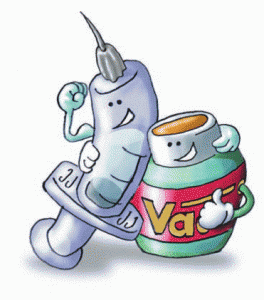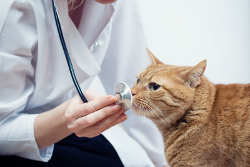Cats are at risk for contracting a number of intestinal parasites. One of the most common is tapeworms. They do not belong to the same family as roundworms and hookworms. Tapeworms are classified as cestodes.
There are several types of tapeworms known to infect cats. The most common species found in cats is Dipylidium caninum. Tapeworms use their mouth to anchor themselves onto the lining of the small intestines. There, they may reach several inches in length by feeding on nutrients.
As the adult tapeworm matures, segments of its body called proglottids break off and are passed in the cat’s stool. The proglottid segments can contain up to twenty tapeworm eggs. Eventually, the segments harden and burst open, releasing tapeworm eggs into the environment where they can continue to spread.
Your Cat’s Role in the Tapeworm Lifecycle
In order for a cat to be infected with tapeworms, the cat has to ingest a flea. Fleas are the intermediate host in the tapeworm’s lifecycle. Dipylidium caninum cannot complete its lifecycle without fleas inhabiting the environment.
The cycle begins when flea larvae ingest tapeworm eggs. In this immature stage, fleas come into contact with tapeworm eggs through contaminated carpet or bedding. The infected flea larvae then mature into adult fleas as hosts.
If a host flea bites your cat and she licks or chews her skin in response, she may inadvertently swallow the flea. The ingestion could also occur during routine grooming. The flea is then digested and the tapeworm inside the flea is released.
After it hatches, the tapeworm attaches itself to the intestinal wall where it will grow and mature. When proglottids consisting of tapeworm eggs break off and are passed in the cat’s stool, the life cycle is complete.
Clinical Signs of Tapeworm Infection
Your cat’s behavior may give no indication that she’s suffering from a tapeworm infection. They are relatively harmless and produce very mild, if any, clinical symptoms. Although, in large numbers they have been known to cause unexplained weight loss.
The most common reason cats are taken to their veterinarian with a suspicion of worms is due to the proglottids. They are easily seen in the cat’s stool and may also cling to the fur around the cat’s anus. They are unmistakable, resembling sesame or cucumber seeds.
Your cat may also “scoot”, or drag her bottom along the floor in response to the irritation of the proglottids in and around the anus. In rare cases, a tapeworm may release its attachment to the intestinal lining and travel to the stomach. The cat may then vomit an adult tapeworm that could be several inches in length.
How a Tapeworm Infection is Diagnosed
The diagnosis of a tapeworm infection is dependent on the presence of proglottids in the cat’s stool. It is not common for a tapeworm infection to be diagnosed by a routine fecal examination. In most cases, it is not necessary.
The presence of the segments is an unmistakable sign of a tapeworm infection. They are unique to tapeworms. No other parasite releases proglottids in the same manner as do tapeworms. If you mention to your veterinarian that you’ve noticed them in your cat’s stool or in or around your cat’s bottom, a firm diagnosis can be made.
 Treatment for Tapeworm Infections
Treatment for Tapeworm Infections
The most effective treatment is provided by your veterinarian. There are a number of products available over-the-counter to treat tapeworms, but most of them are not as effective as the anthelmintic your veterinarian can prescribe.
A one-time dose is often administered as a tablet or injection. The tapeworm then dies and is digested.
Whole worms or segments do not pass into the stool. Side effects of treatment are mild and not commonly reported.
They include vomiting or diarrhea. The possibility of side effects has lessened further with the newer medication used.
Prevention is Key
Flea control is the best way to prevent tapeworm infections. Flea prevention products have become extremely convenient and effective. Most preventatives are administered once a month. They protect against fleas and various other parasites.
There are several administration options including a monthly pill given orally or a liquid that is absorbed through the skin between the shoulder blades. These medications have little to no side effects. They are also relatively inexpensive. They can be obtained through your veterinarian or online. Your veterinarian will assess your cat’s health and individual circumstance in order to offer the best option.
Some cats will not tolerate being administered a pill, while a topical solution may be more difficult others. It is also important to mention that over time, your cat may develop a tolerance to the medication in their parasite prevention.
If this occurs, your veterinarian will simply switch your cat to another product that has a different active ingredient. This switching of medication may continue for the duration of your cat’s life. Parasite prevention is crucial for optimal health and should begin as soon as possible to avoid parasites altogether.
For flea infestations in the environment, measures can be taken to rid your cat’s area and yard of fleas. Ask your veterinarian for the best option considering your cat’s individual circumstance. If she is allowed outside, for example, there are products to rid the yard of fleas.
If she is indoors only, there are carpet powders and other options. If there are other pets in your home, it would be beneficial to start them on flea prevention also. This will eliminate the probability of reinfection and greatly improve the quality of life for all your pets.
Thanks for visiting www.catdandruffclinic.com, if you liked this article please like us using the side bar .


Comments are closed.